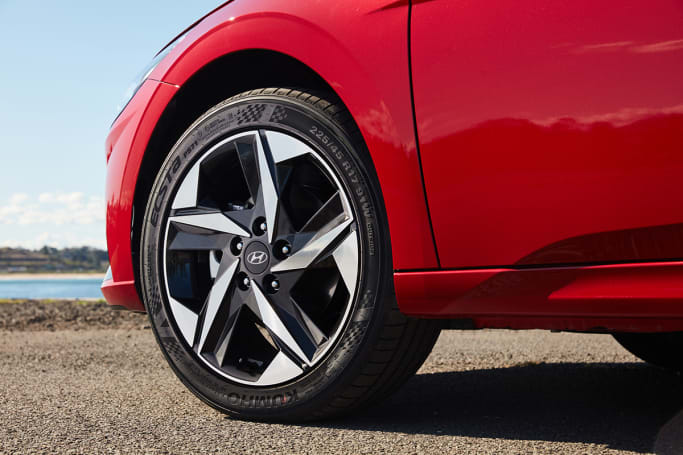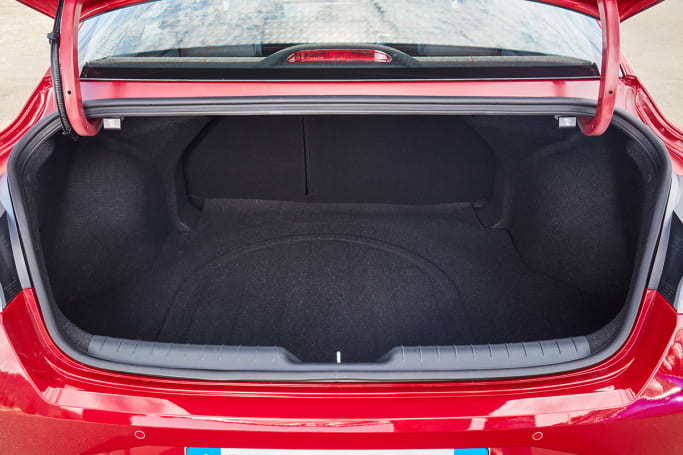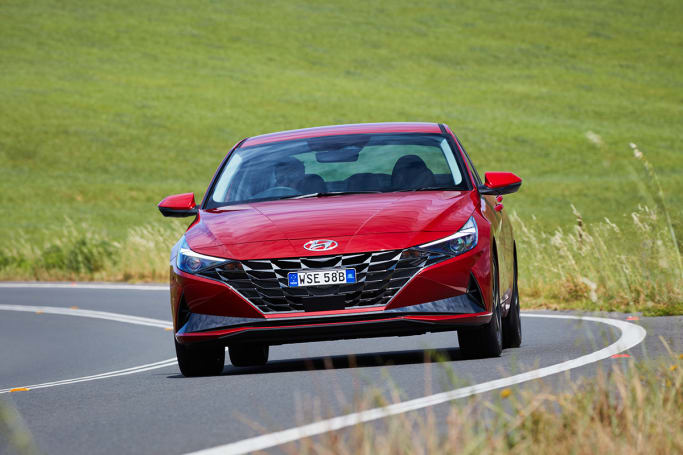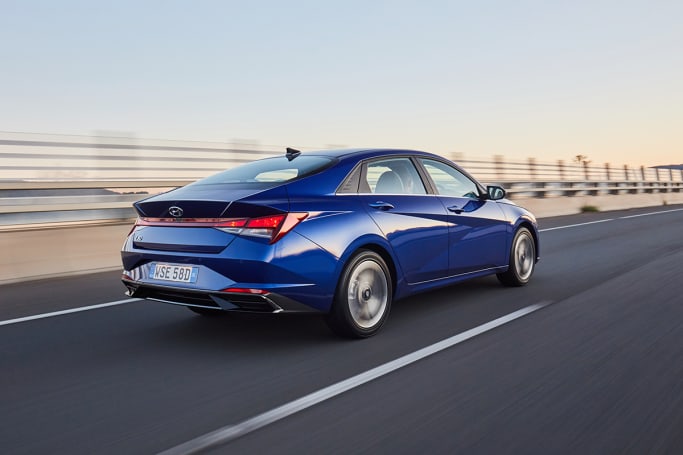
Toyota Corolla 2020 review: sedan
The new-generation Corolla Sedan has arrived and this time it could be better than its hatchback sibling.
Browse over 9,000 car reviews
The Hyundai i30 Sedan is the artist formerly known as the Elantra, with the brand renaming its small-car sedan to make a little more sense in its line-up.
But it's more than an Elantra with a new name. The all-new i30 Sedan rides on a new platform, wears a new design, carries new technology and new safety equipment, and falls under a new - and more expensive - price structure.
Is that enough to put sedans back on the small-car map? Or is it destined to play second fiddle the i30 hatch? Let's find out.
| Hyundai I30 2021: Active | |
|---|---|
| Safety rating | |
| Engine Type | 2.0L |
| Fuel Type | Regular Unleaded Petrol |
| Fuel Efficiency | 7L/100km |
| Seating | 5 seats |
| Price from | $21,340 |
The i30 Sedan range kicks off with the Active trim, available as a six-speed manual ($24,790) or a six-speed automatic ($26,790), before stepping up to the auto-only Elite trim at $30,790 - all about $3000 more than the hatch.
Before the end of the year they'll be joined by the sporty-flavoured N Line models, available in manual ($30,290) or seven-speed DCT automatic ($32,390), or the fancy-feeling N Line Premium, for $37,290.
Active cars get 17-inch alloy wheels, a leather-appointed interior, wireless smartphone charging, an 8.0-inch touchscreen with Apple CarPlay and Android Auto, as well as a comprehensive safety suite - which we'll circle back to under the Safety sub heading.

Elite cars add dual-zone climate control, twin 10.25-inch screens - one in the centre of the dash, the other in front of the driver - with satellite navigation, a BOSE eight-speaker stereo and DAB+ digital radio.
Finally, N Line cars will add a sportier engine, unique bodykit with new-look front and rear bumpers, and a new mesh grille. There's also twin exhaust tips, LED headlights and taillights, and 18-inch alloys, while the N Line Premium adds a sunroof, front parking sensors, 10-way power adjustable, heated and ventilated front seats and a heated steering wheel.

The i30 Sedan continues Hyundai's adventurous Sensuous Sportiness design language, though CarsGuide opinions are a little split on how successfully it's been applied here.
The front-end looks sharp and shapely, with a cat-clawed bonnet split by two swept-back headlights. The bonnet points down towards the tarmac, with these angular inverts on either side that, in Elite models, house deep-set fog lights.
The body, too, is a collection of sharp lines and angles, but both it and the front-on view look accomplished and premium, in our humble opinion.
It's the rear, though, that raises the questions, with the lip of the boot jutting out dramatically before angling in sharply before jutting back out again, a little little a pyramid laying on its side. It's adventurous, no doubt, but it might not be to everyone's taste.
The ambience in the cabin of the i30 Sedan depends on which one you're sitting in. The Elite models are lovely - all quality-feeling materials (save the hard plastics on the upper doors), including a vaguely denim-feeling fabric that trims the inner door panels, and those big twin screens that feel plenty tech savvy.
The Active model makes do without the niceties, though, feeling decidedly cheaper inside - a feeling not helped by the fact the smaller 8.0-inch touchscreen is housed in the same surround as the bigger 10.25-inch screen, meaning you're suddenly confronted by a lot of flat, black plastic.
It's a small sedan, but it doesn't feel small. It's longer and more practical than the hatch, for example - at least in terms of seats-up boot space - and there's a surprising amount of room for rear-seat passengers, too.
This is a seriously spacious backseat - at least for those in the window seats - with a heap of room between my knees and my own 175cm driving position, and plenty of headroom, too. Yes, three adults across the back will prove a squeeze - this is a small car, after all - but two can ride in comfort.
The rear seat is split by a pulldown divider that's home to two cupholders, there's bottle storage in the doors, and two ISOFIX attachment points, too.
Upfront, the cabin feels plenty spacious, and the light-coloured, denim-look materials used in the Elite models add a sense of airiness not found in the cheaper, more plasticky Active models. Up front riders get cupholders, bottle holders in the doors, twin USB connection points, a power outlet, and wireless charging for phones.
Cubbies abound, too, including one at knee height under the dash, and more in the doors and centre console.
Hyundai says the i30 Sedan will swallow some 474 litres (VDA) of luggage, up from 395 litres in the hatch - with the rear seats in place - and around 1350L with the seats folded flat.

It's a pretty tried and true powertrain this, with the i30 Sedan Active and Elite both fitted with Hyundai's 2.0-litre petrol engine producing 117kW and 191Nm, pairing with a six-speed manual or a six-speed automatic.

The combo feels dependable, rather than exhilarating, but does produce enough grunt to get you humming along easily enough. Frustratingly, there are some super-clever hybrid-assisted powertrains available internationally, but we don't get them in Australia. At least, not yet.
Hyundai says the 2.0-litre engine will sip around 7.0L/100km on the combined cycle, but is yet to reveal C02 emissions.
It's not an excitement machine, the i30 Sedan (the incoming N Line models with their turbocharged engines should better fulfil that role) but what it lacks in outright speed it makes up for with its road manners.
We came away impressed with its ride and handling balance, with the newest Hyundai feeling genuinely competent in corners - so much so that we were longing for more grunt - yet comfortable on the dodgy road surfaces of the city, too.

Part of that is likely down to Hyundai's local chassis tuning, but could also be down to the fact the Sedan rides on a new and different platform (the K3) to its hatch sibling. Either way, this i30 balances the dual roles of comfort and connection to the road below with aplomb.
There are some downsides, though. The engine, though providing enough shove to move you around fairly easily, lacks the urgency required for overtaking or for spirited take-offs. Instead, planting your right foot makes things get louder and more gruff in the cabin, without producing much in the way of extra performance. You're far better off treating it gently, and letting it do its thing without asking too much of it.

It's an easy, breezy, largely care-free drive. It won't get your heart beating any faster, but nor will it have you kung-fu-gripping the steering wheel in frustration. But we do wish Hyundai could have gotten its hands on those European mild-hybrid engines.
Basic Warranty
5 years / unlimited km warranty
ANCAP Safety Rating

Safety is an interesting one, given Hyundai won't be submitting this vehicle for ANCAP testing. Recent changes to the testing regime require the addition of a central airbag to qualify for a full five-star rating, and the i30 Sedan doesn't have one, meaning it would likely max out at four stars.
Does that mean it's unsafe? Nope. Just that ANCAP's testing requirements are moving quickly, and not all cars have managed to keep up.

You'll find six airbags, along with the usual braking and traction aids, before the tech steps up to the active safety stuff, like AEB with pedestrian and cyclist detection, as well as junction detection, plus lane keep assist, lane following assist and active cruise - all in the Active model. The Elite trim then adds blind-spot monitoring, rear cross-traffic alert and rear parking sensors.
The Hyundai i30 Sedan is covered by a five-year, unlimited-kilometre warranty, and requires servicing every 15,000kms. Capped-price servicing is available throughout, too.
The i30 Sedan improved on the Elantra formula in every way, provided the new and adventurous design language speaks to your tastes. It does feel more advanced in the cabin than it does under the bonnet, though.
| Vehicle | Specs | Price* | |
|---|---|---|---|
| (base) | 2.0L, ULP, 6 SP AUTO | $21,230 – 26,840 | 2021 Hyundai i30 2021 (base) Pricing and Specs |
| Active | 2.0L, ULP, 6 SP AUTO | $22,990 – 28,380 | 2021 Hyundai i30 2021 Active Pricing and Specs |
| Active | 2.0L, ULP, 6 SP MAN | $21,340 – 27,060 | 2021 Hyundai i30 2021 Active Pricing and Specs |
| Elite | 2.0L, ULP, 6 SP SEQ AUTO | $27,720 – 33,440 | 2021 Hyundai i30 2021 Elite Pricing and Specs |
| Price and features | 8 |
|---|---|
| Design | 7 |
| Practicality | 8 |
| Under the bonnet | 7 |
| Efficiency | 8 |
| Driving | 8 |
| Safety | 8 |
| Ownership | 8 |
$16,990
Lowest price, based on 517 car listings in the last 6 months